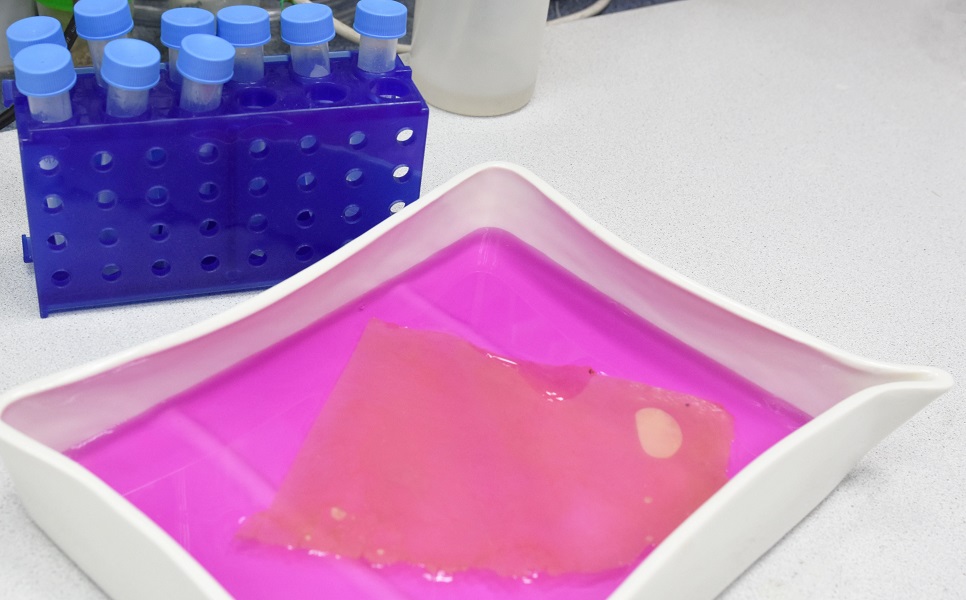Is it possible to grow the third set of teeth?
Our researchers will check it out
Researchers from Warsaw University of Technology, in cooperation with Poznan University of Medical Sciences, have initiated a project to determine whether it is possible to grow the third set of teeth from stem cells located in the gums.
Dentists have observed that the oral cavity has a very high regenerative potential. In the place of a removed tooth, for example, the bone structure, cartilage, epithelial and nerve tissues are all regenerated. We do not lose sensation in this part of the mandible or palate.
– We hypothesized that gingival tissues, in particular a certain subset of stem cells, have the ability to transform into different structures. – says Agnieszka Gadomska-Gajadhur, DSc PhD Eng. from the Faculty of Chemistry at WUT, manager of the SteamScaf project. – We want to explore the possibilities of their application. We will discover what kinds of tissues can be produced from them – she explains.
Inter-university cooperation and more
The research will be conducted together with a team from the Karol Marcinkowski University of Medical Sciences in Poznań, which will be responsible for cell differentiation. It is headed by Prof. Bartosz Kempisty, and, in the stomatological field, is supported by Marta Dyszkiewicz-Konwińska, MD PhD. from the Department of Diagnostics. The goal will be to differentiate cells taken from porcine gums toward bone, cartilage, or nervous tissue.
The Warsaw University of Technology team's role is to provide a carrier on which stem cells can grow and transform into tissue. Researchers already have some ideas.
– We synthesize the materials from which these scaffolding will be made. The materials will be completely biocompatible and resorbed, which means they will be absorbed after some time, as well as biomimetic, based on the elements found in human bodies. Ultimately, we would like to supply these cells with certain growth factors. According to Agnieszka Gadomska-Gajadhur, DSc PhD Eng., the scaffolding will primarily have a fibrous structure, similar to that of fabric.
The researchers also intend to collaborate with two foreign facilities, one in the United Kingdom and the other in the Czech Republic, which specialize in determining the characteristics of differentiated cells. They will ensure that the resulting tissue is of full value and will assess whether it is bone, cartilage, or a mix of the two.
Alternative solution
The Japanese have already developed the ability to produce tooth buds in the laboratory. For this, however, they use stem cells from banked umbilical cord blood. They have a lot of it there, whereas in Poland we practically do not. There was no such technique in the past, and an alternative should be sought, for example, for the elderly who require bone or teeth replacement materials.
And what about implants? - Most people believe that when teeth fall out, implants are the simplest option. Unfortunately, each such intervention, whether screwing in or removing implants, causes the natural human bone to weaken, making the next procedure more difficult – explains Agnieszka Gadomska-Gajadhur, DSc PhD Eng.
Additionally, when a patient has an autoimmune disease, such as Hashimoto's, the body frequently attacks the tissue surrounding the implant. Inflammation around the implants is also common - this is known as periimplantitis and can lead to implant loss. We still do not have remedies that can effectively restore the dentition's physiological functions in a long-term.
Hope for a continuation
If the part dealing with nervous tissue is similarly effective, it will be feasible to grow individual neurons or nervous tissue fragments. Researchers see enormous potential for transplants, such as in the spinal cord or peripheral nerves, within paralyzed limb segments.
– Quite honestly, this is probably the most challenging part of the project, but if our gums can repair nerves after tooth extraction, why not try? – emphasizes Agnieszka Gadomska-Gajadhur, DSc PhD Eng.
More tests may be performed if the results are positive.
– We are already considering a project involving stem cells that we would like to acquire from dental patients. We were forced to use the pig model since we were dealing with an acute epidemic and fewer tooth extractions were performed. We were afraid that we would receive very little material and chose the human-like, more accessible option. Ultimately, however, we are aiming at a large European project. SteamScaf will tell us which way to proceed – says Agnieszka Gadomska-Gajadhur, DSc PhD Eng.
WUT students, Aleksandra Bandzerewicz, BSc, and Joanna Howis, BSc are also involved in the project.
The "Biomimetic, biodegradable cell substrates for the differentiation of stem cells toward osteoblasts and chondrocytes" project (SteamScaf) („Biomimetyczne, biodegradowalne podłoża komórkowe do różnicowania komórek macierzystych w kierunku osteoblastów i chondrocytów”) will continue until the end of 2023. It is financed under the "The Excellence Initiative - Research University" program implemented at Warsaw University of Technology. It was among the laureates of the competition for research grants "BIOTECHMED-3: Advanced" of the POB Biotechnology and Biomedical Engineering Research Centre.








